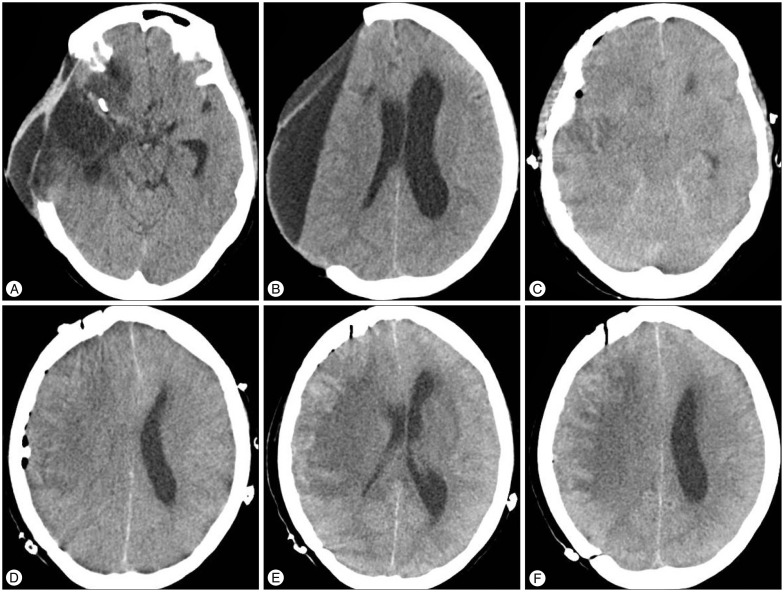J Korean Neurosurg Soc.
2015 Jul;58(1):76-78. 10.3340/jkns.2015.58.1.76.
Unexpected Severe Cerebral Edema after Cranioplasty : Case Report and Literature Review
- Affiliations
-
- 1Department of Neurosurgery, Soonchunhyang University Seoul Hospital, Soonchunhyang University College of Medicine, Seoul, Korea. drcolor@schmc.ac.kr
- KMID: 2067109
- DOI: http://doi.org/10.3340/jkns.2015.58.1.76
Abstract
- This report details a case of unexpected, severe post-operative cerebral edema following cranioplasty. We discuss the possible pathological mechanisms of this complication. A 50-year-old female was admitted to our department with sudden onset of stuporous consciousness. A brain computed tomography (CT) revealed a subarachnoid hemorrhage with intracranial hemorrhage and subdural hematoma. Emergency decompressive craniectomy and aneurysmal neck clipping were performed. Following recovery, the decision was made to proceed with an autologous cranioplasty. The cranioplasty procedure was free of complications. An epidural drain was placed and connected to a suction system during skin closure to avoid epidural blood accumulation. However, following the procedure, the patient had a seizure in the recovery room. An emergency brain CT scan revealed widespread cerebral edema, and the catheter drain was clamped. The increased intracranial pressure and cerebral edema were controlled with osmotic diuretics, corticosteroids, and antiepileptic drugs. The edema slowly subsided, but new low-density areas were noted in the brain on follow-up CT 1 week later. We speculated that placing the epidural drain on active suction may have caused an acute decrease in intracranial pressure and subsequent rapid expansion of the brain, which impaired autoregulation and led to reperfusion injury.
MeSH Terms
-
Adrenal Cortex Hormones
Aneurysm
Anticonvulsants
Brain
Brain Edema*
Catheters
Consciousness
Decompressive Craniectomy
Diuretics, Osmotic
Edema
Emergencies
Female
Follow-Up Studies
Hematoma, Subdural
Homeostasis
Humans
Intracranial Hemorrhages
Intracranial Pressure
Middle Aged
Neck
Recovery Room
Reperfusion Injury
Seizures
Skin
Stupor
Subarachnoid Hemorrhage
Suction
Tomography, X-Ray Computed
Adrenal Cortex Hormones
Anticonvulsants
Diuretics, Osmotic
Figure
Cited by 1 articles
-
Sudden Death Following Cranioplasty
Stephen Honeybul
J Korean Neurosurg Soc. 2016;59(2):182-184. doi: 10.3340/jkns.2016.59.2.182.
Reference
-
1. Cecchi PC, Rizzo P, Campello M, Schwarz A. Haemorrhagic infarction after autologous cranioplasty in a patient with sinking flap syndrome. Acta Neurochir (Wien). 2008; 150:409–410. discussion 411PMID: 18246457.
Article2. Chang V, Hartzfeld P, Langlois M, Mahmood A, Seyfried D. Outcomes of cranial repair after craniectomy. J Neurosurg. 2010; 112:1120–1124. PMID: 19612971.
Article3. De Bonis P, Frassanito P, Mangiola A, Nucci CG, Anile C, Pompucci A. Cranial repair : how complicated is filling a "hole"? J Neurotrauma. 2012; 29:1071–1076. PMID: 22059899.4. Gooch MR, Gin GE, Kenning TJ, German JW. Complications of cranioplasty following decompressive craniectomy : analysis of 62 cases. Neurosurg Focus. 2009; 26:E9. PMID: 19485722.5. Honeybul S. Sudden death following cranioplasty : a complication of decompressive craniectomy for head injury. Br J Neurosurg. 2011; 25:343–345. PMID: 21501058.
Article6. Honeybul S, Ho KM. Long-term complications of decompressive craniectomy for head injury. J Neurotrauma. 2011; 28:929–935. PMID: 21091342.
Article7. Honeybul S, Janzen C, Kruger K, Ho KM. The impact of cranioplasty on neurological function. Br J Neurosurg. 2013; 27:636–641. PMID: 23883370.
Article8. Isago T, Nozaki M, Kikuchi Y, Honda T, Nakazawa H. Sinking skin flap syndrome : a case of improved cerebral blood flow after cranioplasty. Ann Plast Surg. 2004; 53:288–292. PMID: 15480019.9. Kwon SM, Cheong JH, Kim JM, Kim CH. Reperfusion injury after autologous cranioplasty in a patient with sinking skin flap syndrome. J Korean Neurosurg Soc. 2012; 51:117–119. PMID: 22500207.
Article10. Roth J, Galeano E, Milla S, Hartmannsgruber MW, Weiner HL. Multiple epidural hematomas and hemodynamic collapse caused by a subgaleal drain and suction-induced intracranial hypotension : case report. Neurosurgery. 2011; 68:E271–E275. discussion E276PMID: 21099705.11. Santana-Cabrera L, Pérez-Ortiz C, Rodríguez-Escot C, Sánchez-Palacios M. Massive postoperative cerebral swelling following cranioplasty. Int J Crit Illn Inj Sci. 2012; 2:107–108. PMID: 22837899.
Article12. Wachter D, Reineke K, Behm T, Rohde V. Cranioplasty after decompressive hemicraniectomy : underestimated surgery-associated complications? Clin Neurol Neurosurg. 2013; 115:1293–1297. PMID: 23273384.
Article
- Full Text Links
- Actions
-
Cited
- CITED
-
- Close
- Share
- Similar articles
-
- Sudden Unexpected Death caused by Olfactory Groove Meningioma: A Case Report
- Exertional heat stroke with reversible severe cerebral edema
- In Situ Floating Resin Cranioplasty for Cerebral Decompression
- Reperfusion Injury after Autologous Cranioplasty in a Patient with Sinking Skin Flap Syndrome
- Multiple Cerebral Hemorrhages Caused by Paradoxical Reperfusion Injury After Cranioplasty



